中国近代民族主义的艰难历程【英文】
- 格式:ppt
- 大小:9.70 MB
- 文档页数:26
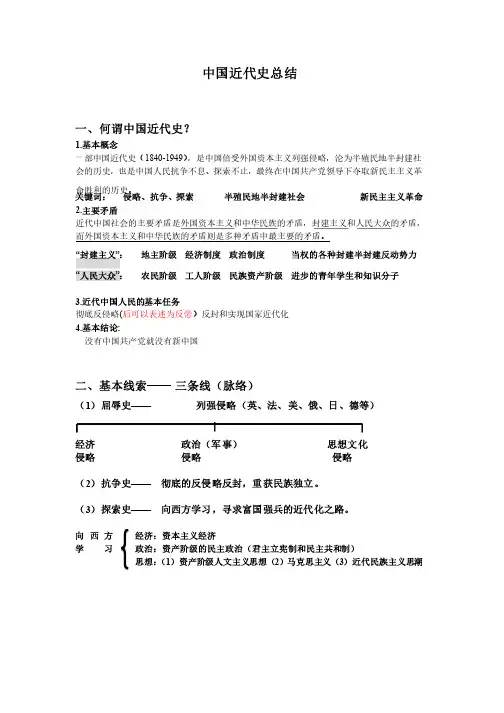
中国近代史总结一、何谓中国近代史?1.基本概念一部中国近代史(1840-1949),是中国倍受外国资本主义列强侵略,沦为半殖民地半封建社会的历史,也是中国人民抗争不息、也是中国人民抗争不息、探索不止,探索不止,最终在中国共产党领导下夺取新民主主义革命胜利的历史。
命胜利的历史。
关键词: 侵略、抗争、探索 半殖民地半封建社会 新民主主义革命 2.主要矛盾近代中国社会的主要矛盾是外国资本主义和中华民族的矛盾,封建主义和人民大众的矛盾,而外国资本主义和中华民族的矛盾则是多种矛盾中最主要的矛盾。
而外国资本主义和中华民族的矛盾则是多种矛盾中最主要的矛盾。
“封建主义”:地主阶级 经济制度 政治制度 当权的各种封建半封建反动势力 “人民大众”:农民阶级 工人阶级 民族资产阶级 进步的青年学生和知识分子3.近代中国人民的基本任务彻底反侵略(后可以表述为反帝)反封和实现国家近代化)反封和实现国家近代化 4.基本结论: 没有中国共产党就没有新中国没有中国共产党就没有新中国——二、基本线索—— 三条线(脉络)(1)屈辱史—— 列强侵略(英、法、美、俄、日、德等)经济 政治(军事) 思想文化 侵略 侵略 侵略(2)抗争史—— 彻底的反侵略反封,重获民族独立。
(3)探索史—— 向西方学习,寻求富国强兵的近代化之路。
向西方 经济:资本主义经济 学习 政治:资产阶级的民主政治(君主立宪制和民主共和制)思想:(1)资产阶级人文主义思想(2)马克思主义(3)近代民族主义思潮地主阶级:洋务运动(十九世纪六十年代至甲午中日战争) 工人阶级(中国共产党):新民主主义革命时期(1919-1949)民族资产阶级: 戊戌变法、辛亥革命、新文化运动 近代社会各阶级的抗争与探索三、中国近代史的发展阶段(分期):四、近代中国政权的沿革晚清政权(1840-1911年) 北洋军阀政权(1912-1928年) 南京国民党政权(1927-1949年)南京临时政府(1912年)五、基本概念:▲半殖民半封建社会不能机械地理解为“半殖民地”是政治的,“半封建”是经济的。
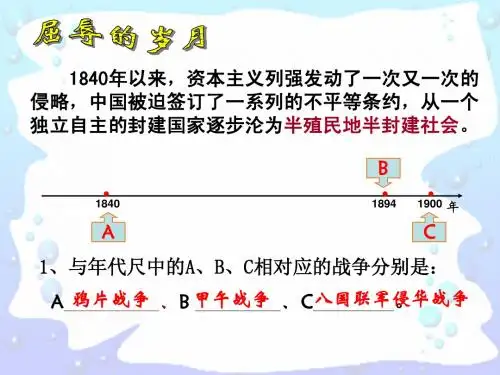
![[笔记]十九世纪德意志民族主义的发展](https://uimg.taocdn.com/f289ce4b3a3567ec102de2bd960590c69ec3d88b.webp)
十九世纪德意志民族主义的发展阮芬历史01级内容摘要:19世纪德意志民族主义的发展变化很大,大致经历了文化民族主义、政治民族主义、极端民族主义三个阶段。
由于德意志的分裂和法国的影响,德意志文化民族主义逐渐形成、发展。
拿破仑战争时德意志的惨败激发了德意志人的民族情感,强烈要求国家、民族的统一,德意志民族主义由文化领域转到政治领域。
普鲁士统一德意志的强权政治,威廉二世的统治,使得民族主义开始走向极端的一面。
关键词: 19世纪;德意志;民族主义Abstract:The development of German nationalism greatly diversified in nineteenth century. There were cultural nationalism, political nationalism and extreme nationalism. For disunion of Germany and influence of France, German cultural nationalism developed gradually. Napoleon’s army defeated Germen’s. It shocked Germen, so they strongly demanded unity of state and nation. And German nationalism changed from culture to politics. The power of Prussia used in unifying Germany and the rule of WilliamⅡmade nationalism begin to develop extremely.Key Words: nineteenth century; Germany; nationalism民族主义在不同的环境、不同的时期、不同的民族历经不同的发展,因而关于民族主义的定义也不尽相同。
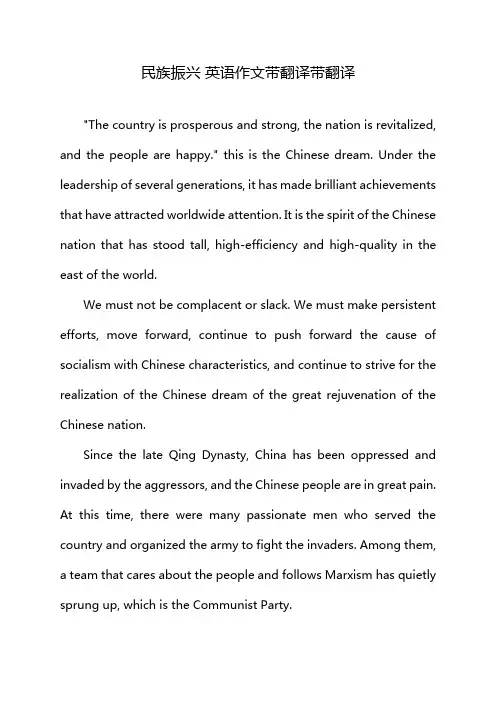
民族振兴英语作文带翻译带翻译"The country is prosperous and strong, the nation is revitalized, and the people are happy." this is the Chinese dream. Under the leadership of several generations, it has made brilliant achievements that have attracted worldwide attention. It is the spirit of the Chinese nation that has stood tall, high-efficiency and high-quality in the east of the world.We must not be complacent or slack. We must make persistent efforts, move forward, continue to push forward the cause of socialism with Chinese characteristics, and continue to strive for the realization of the Chinese dream of the great rejuvenation of the Chinese nation.Since the late Qing Dynasty, China has been oppressed and invaded by the aggressors, and the Chinese people are in great pain. At this time, there were many passionate men who served the country and organized the army to fight the invaders. Among them, a team that cares about the people and follows Marxism has quietly sprung up, which is the Communist Party.The emergence of the Communist Party has saved millions of people. So that the brutal and merciless fascists have withdrawn from the stage of history forever. So that we, the Han people and the 56 ethnic minorities, can establish a regional power, the people's Republic of China.Since then, no one dares to invade China, nor does any country dare to harass China, because they understand that China has a strong fighting capacity, which is the most populous country in the world. China has outstanding leaders. China is confident and self-improvement. China believes that the Chinese dream will be realized."Building a well-off society in an all-round way" is an important way for China to achieve revitalization and the foundation for prosperity.As early as the 1970s, Deng Xiaoping put forward "building a well-off society for all and accelerating the pace of China's prosperity". The Chinese people are working hard! The Chinese nation is struggling! Fighting! Building a well-off society!China is now fully modernizing its chemical industry and increasing its gross national product. Since joining the WTO in 2001,China has been moving towards prosperity and rejuvenation step by step. China has expanded its overseas trade market and absorbed a large number of talents. Today, China's aerospace industry and nuclear industry have an indelible position in the world. China has developed step by step and become one of the five permanent members of the United Nations.To realize the Chinese dream, we must take the Chinese road; Must carry forward the Chinese spirit; We must pool China's strength.“国家富强,民族振兴,人民幸福,”这就是中国梦。

近代中国1.近代中国的民主革命(1)1840—1900年间列强侵略与中国人民的反抗斗争1、(湛江2011二模)15.1854年英国外交大臣克勒拉德恩说:“自从条约缔结以来,因我们对华通商在扩展有限而感到的许多失望……届时我们当有权要求中英条约修订。
”话中“自从条约缔结以来”指的是A .《南京条约》B .《天津条约》C .《北京条约》D .《辛丑条约》2、(广州2011二模)15.“19世纪中叶,西方的影响虽然消弱了清政府的权威,但是,清政府真正的权威危机是来源于农民的造反运动与内部阶层的分离倾向。
”“农民的造反运动与内部阶层的分离倾向”是指A .太平天国运动和洋务运动B .义和团运动和戊戌变法C .太平天国运动和戊戌变法D .义和团运动和洋务运动3、(肇庆2011一模)14.右为《天朝田亩制度》书摘,从“有田同耕,有饭同食,有衣同穿,有银同使,无处不均匀,无人不饱暖”等语,可知太平天国的理想境地是A .共产与民主B .共产与平等C .平等与自由D .民主与科学4、某年,英国伦敦一本杂志上刊登了一幅新闻漫画,描绘了日本人形象。
解析右图,该新闻事件应该A .甲午中日战争B .巴黎和会C .抗日战争D .明治维新(2)戊戌变法(3)辛亥革命1、(湛江2011一模)18.今年是辛亥革命爆发100周年,北京、南京、武汉、广州、中山都想申请纪念活动主办权,其中南京的理由是A .辛亥革命在南京爆发B .在南京实现了第一次图共合作C .中华民国在南京成立,并颁布《临时约法》D .三民主义在南京提出2、(韶关2011一模)15.印度的高中历史教科书如是比较了中国和日本的现代化道路:“日本成功地发扬了传统使之适应新的时代,……;而中国选择的是放弃传统,破旧立新。
”其立论主要着眼于中国的A .明治维新B .洋务运动C .戊戌变法D .辛亥革命3、(湛江2011二模)16.N .佩弗《远东》一书认为:“1912年在中国建立起美国共和政体的仿制品,真是荒唐可笑……这种共和政体悲惨的结束了,即悲惨的失败了。
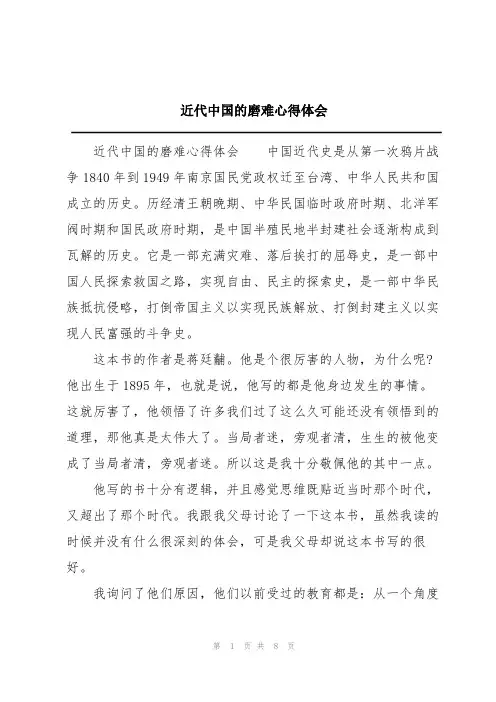
近代中国的磨难心得体会近代中国的磨难心得体会中国近代史是从第一次鸦片战争1840年到1949年南京国民党政权迁至台湾、中华人民共和国成立的历史。
历经清王朝晚期、中华民国临时政府时期、北洋军阀时期和国民政府时期,是中国半殖民地半封建社会逐渐构成到瓦解的历史。
它是一部充满灾难、落后挨打的屈辱史,是一部中国人民探索救国之路,实现自由、民主的探索史,是一部中华民族抵抗侵略,打倒帝国主义以实现民族解放、打倒封建主义以实现人民富强的斗争史。
这本书的作者是蒋廷黼。
他是个很厉害的人物,为什么呢?他出生于1895年,也就是说,他写的都是他身边发生的事情。
这就厉害了,他领悟了许多我们过了这么久可能还没有领悟到的道理,那他真是太伟大了。
当局者迷,旁观者清,生生的被他变成了当局者清,旁观者迷。
所以这是我十分敬佩他的其中一点。
他写的书十分有逻辑,并且感觉思维既贴近当时那个时代,又超出了那个时代。
我跟我父母讨论了一下这本书,虽然我读的时候并没有什么很深刻的体会,可是我父母却说这本书写的很好。
我询问了他们原因,他们以前受过的教育都是:从一个角度评判整个历史,相对来说,角度比较单一。
那里面并没有否认他们是英雄,而是客观的给予他们一个正确的评价。
就比如林则徐:老式教育是,主张严禁鸦片,在中国有民族英雄之誉。
这本书里写的是,苛刻的,不考会虑大局的。
可是他自我意识到了,可是人民却陷下去了。
那为什么我的父母觉得这本书很好,可是我的感觉却不深呢?这是因为没有比较,就没有伤害。
正是因为此书写的与他们学的不一样,他们才有深刻的体会。
可是我们从小就受到这种良好的教育,真是身在福中不知福。
此书出版与中国华侨出版社,利用政治学和历史学结合所写,新华书店经销,字数188千字,特点是精炼油和经典,19年5月第13次印刷。
这本书受人追捧,也值得读好多遍!近代中国的磨难心得体会这个学期我学习了《中国近现代史纲要》这门课程,短短几个月的学习与积累,我收获颇多,也深有感触。
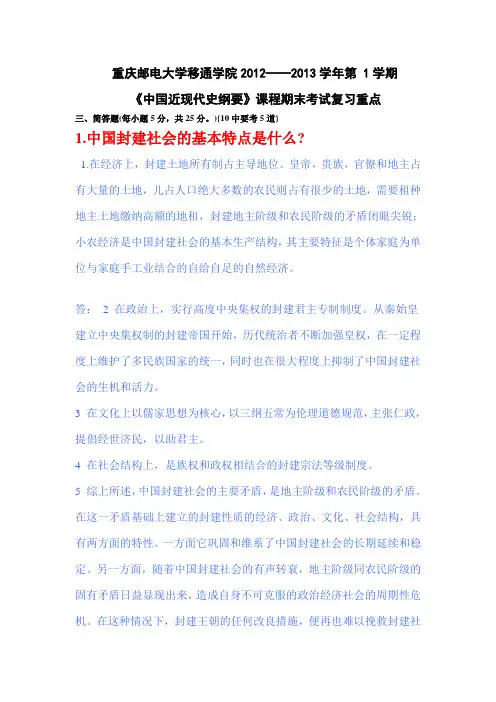
重庆邮电大学移通学院2012——2013学年第 1学期《中国近现代史纲要》课程期末考试复习重点三、简答题(每小题5分,共25分。
){10中要考5道}1.中国封建社会的基本特点是什么?1.在经济上,封建土地所有制占主导地位。
皇帝,贵族,官僚和地主占有大量的土地,儿占人口绝大多数的农民则占有很少的土地,需要租种地主土地缴纳高额的地租,封建地主阶级和农民阶级的矛盾闭眼尖锐;小农经济是中国封建社会的基本生产结构,其主要特征是个体家庭为单位与家庭手工业结合的自给自足的自然经济。
答:2 在政治上,实行高度中央集权的封建君主专制制度。
从秦始皇建立中央集权制的封建帝国开始,历代统治者不断加强皇权,在一定程度上维护了多民族国家的统一,同时也在很大程度上抑制了中国封建社会的生机和活力。
3 在文化上以儒家思想为核心,以三纲五常为伦理道德规范,主张仁政,提倡经世济民,以助君主。
4 在社会结构上,是族权和政权相结合的封建宗法等级制度。
5 综上所述,中国封建社会的主要矛盾,是地主阶级和农民阶级的矛盾。
在这一矛盾基础上建立的封建性质的经济、政治、文化、社会结构,具有两方面的特性。
一方面它巩固和维系了中国封建社会的长期延续和稳定。
另一方面,随着中国封建社会的有声转衰,地主阶级同农民阶级的固有矛盾日益显现出来,造成自身不可克服的政治经济社会的周期性危机。
在这种情况下,封建王朝的任何改良措施,便再也难以挽救封建社会的社会危机。
2、近代中国社会的主要矛盾和中华民族面临的历史任务。
答:近代中国社会的主要矛盾,是外国资本主义和中华民族的矛盾,封建主义和人民大众的矛盾;而外国资本主义和中华民族的矛盾,是各种社会矛盾中最主要的矛盾中华民族所面临的历史任务有三通俗的说即孙中山先生的三民主义民权民生民族。
3、戊戌维新运动的历史意义是什么?答:1. 进步意义。
戊戌变法颁布的法令虽然绝大多数都是纸上谈兵,从来没有真正实行过,但它表明历史走向是进步的。
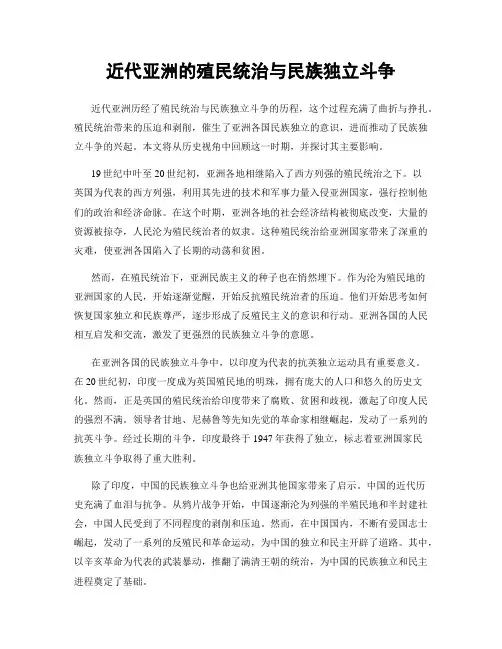
近代亚洲的殖民统治与民族独立斗争近代亚洲历经了殖民统治与民族独立斗争的历程,这个过程充满了曲折与挣扎。
殖民统治带来的压迫和剥削,催生了亚洲各国民族独立的意识,进而推动了民族独立斗争的兴起。
本文将从历史视角中回顾这一时期,并探讨其主要影响。
19世纪中叶至20世纪初,亚洲各地相继陷入了西方列强的殖民统治之下。
以英国为代表的西方列强,利用其先进的技术和军事力量入侵亚洲国家,强行控制他们的政治和经济命脉。
在这个时期,亚洲各地的社会经济结构被彻底改变,大量的资源被掠夺,人民沦为殖民统治者的奴隶。
这种殖民统治给亚洲国家带来了深重的灾难,使亚洲各国陷入了长期的动荡和贫困。
然而,在殖民统治下,亚洲民族主义的种子也在悄然埋下。
作为沦为殖民地的亚洲国家的人民,开始逐渐觉醒,开始反抗殖民统治者的压迫。
他们开始思考如何恢复国家独立和民族尊严,逐步形成了反殖民主义的意识和行动。
亚洲各国的人民相互启发和交流,激发了更强烈的民族独立斗争的意愿。
在亚洲各国的民族独立斗争中,以印度为代表的抗英独立运动具有重要意义。
在20世纪初,印度一度成为英国殖民地的明珠,拥有庞大的人口和悠久的历史文化。
然而,正是英国的殖民统治给印度带来了腐败、贫困和歧视,激起了印度人民的强烈不满。
领导者甘地、尼赫鲁等先知先觉的革命家相继崛起,发动了一系列的抗英斗争。
经过长期的斗争,印度最终于1947年获得了独立,标志着亚洲国家民族独立斗争取得了重大胜利。
除了印度,中国的民族独立斗争也给亚洲其他国家带来了启示。
中国的近代历史充满了血泪与抗争。
从鸦片战争开始,中国逐渐沦为列强的半殖民地和半封建社会,中国人民受到了不同程度的剥削和压迫。
然而,在中国国内,不断有爱国志士崛起,发动了一系列的反殖民和革命运动,为中国的独立和民主开辟了道路。
其中,以辛亥革命为代表的武装暴动,推翻了满清王朝的统治,为中国的民族独立和民主进程奠定了基础。
在亚洲各国的民族独立斗争中,还有一些国家通过非暴力抵抗取得了胜利。
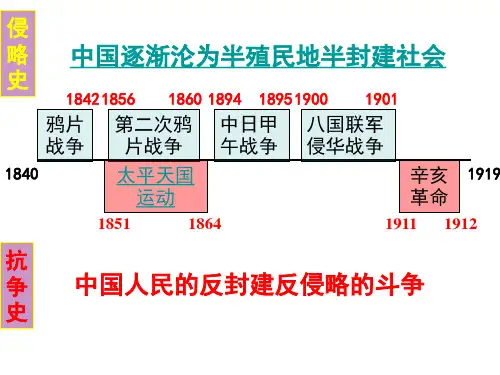
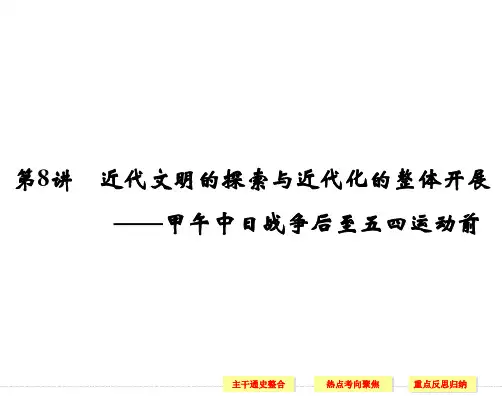
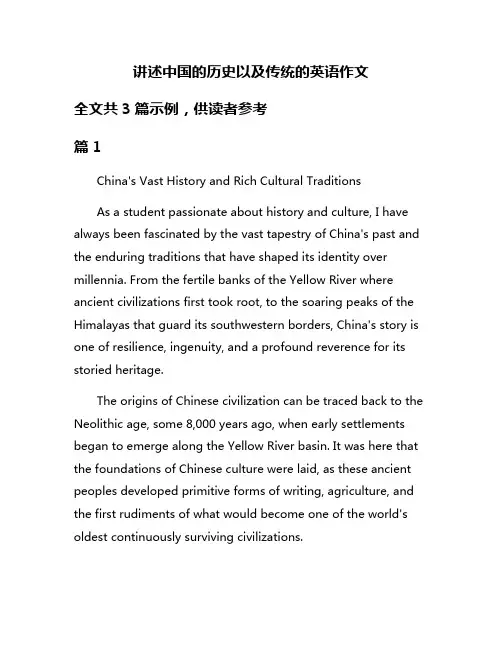
讲述中国的历史以及传统的英语作文全文共3篇示例,供读者参考篇1China's Vast History and Rich Cultural TraditionsAs a student passionate about history and culture, I have always been fascinated by the vast tapestry of China's past and the enduring traditions that have shaped its identity over millennia. From the fertile banks of the Yellow River where ancient civilizations first took root, to the soaring peaks of the Himalayas that guard its southwestern borders, China's story is one of resilience, ingenuity, and a profound reverence for its storied heritage.The origins of Chinese civilization can be traced back to the Neolithic age, some 8,000 years ago, when early settlements began to emerge along the Yellow River basin. It was here that the foundations of Chinese culture were laid, as these ancient peoples developed primitive forms of writing, agriculture, and the first rudiments of what would become one of the world's oldest continuously surviving civilizations.The dynastic era, which spanned from around the 21st century BCE to the early 20th century, witnessed the rise and fall of countless imperial houses, each leaving an indelible mark on the nation's cultural evolution. From the philosophical teachings of Confucius during the Zhou Dynasty, to the unprecedented territorial expansion under the Qin and Han Empires, to the artistic and literary flourishing of the Tang and Song eras, China's dynasties were both catalysts for cultural fusion and bastions of tradition.One of the most enduring legacies of this dynastic period is the Confucian philosophy, which has profoundly influenced Chinese thought, social structures, and cultural norms for over two millennia. Emphasizing virtues such as filial piety, propriety, and the pursuit of harmony, Confucianism has shaped everything from family dynamics to governmental principles. Even today, its precepts continue to exert a subtle yet pervasive influence on Chinese society.Equally emblematic of China's rich cultural heritage are its architectural marvels, which stand as testament to the nation's technological sophistication and aesthetic sensibilities. The Great Wall, serpentining across thousands of miles of rugged terrain, is perhaps the most iconic example, a monumental feat ofengineering that has captured the imagination of generations. The Forbidden City, with its intricate maze of palaces and courtyards, offers a window into the opulent lifestyles of imperial rulers, while the Terra Cotta Warriors in Xi'an provide a haunting glimpse into the funerary rituals of ancient China.Chinese traditions are also deeply intertwined with its diverse ethnic minorities, each adding their own unique threads to the cultural tapestry. From the vibrant festivals of the Dai people in Yunnan, to the intricate embroidery of the Miao in Guizhou, to the haunting melodies of the Mongolian long songs, China's ethnic diversity is a wellspring of cultural richness that has withstood the test of time.Perhaps no aspect of Chinese culture is more celebrated or widely recognized than its culinary traditions. With a history spanning thousands of years and a dizzying array of regional variations, Chinese cuisine is a reflection of the nation's diverse geography, climate, and ethnic influences. From the fiery Sichuan hotpots to the delicate dim sum of Cantonese cuisine, from the hearty noodle dishes of the north to the fragrant curries of Yunnan, Chinese food is a sensory journey that celebrates the bounty of the land and the ingenuity of its people.In the realm of arts and literature, China has produced some of the world's most enduring masterpieces. The ancient Book of Songs, a collection of poetry dating back to the 11th century BCE, is a poignant reflection of the joys and sorrows of everyday life, while the classic novel "Journey to the West" has regaled generations with its tales of mythical adventures and spiritual allegories. Chinese calligraphy, with its fluid brushstrokes and harmonious compositions, is an art form that transcends mere writing, elevating the written word to a visual poetry.As we navigate the complexities of the modern world, it is essential that we look to the past for guidance and inspiration. China's rich cultural heritage, forged over thousands of years and shaped by countless influences, offers a treasure trove of wisdom, resilience, and beauty that can enrich our understanding of what it means to be human.From the philosophical depths of Confucianism to the artistic brilliance of its architecture and literature, from the culinary delights that tantalize the senses to the vibrant tapestry of its ethnic traditions, China's cultural legacy is a testament to the enduring spirit of a civilization that has weathered the storms of history while remaining firmly rooted in its traditions.As a student of this vast and multifaceted culture, I am humbled by the magnitude of what has been bequeathed to us by our ancestors. It is our duty, our privilege, to honor and preserve this extraordinary heritage, for within its annals lie the keys to unlocking a deeper understanding of ourselves and our place in the world.篇2A Vast Tapestry: China's Rich History and Enduring TraditionsAs a student, I've always been fascinated by the vast and ancient history of China, a country whose roots stretch back thousands of years. From the sprawling dynasties that ruled over this vast land to the rich cultural traditions that have been passed down from generation to generation, China's story is a tapestry woven with threads of resilience, innovation, and unwavering pride.Let's start our journey at the very beginning, with the Xia Dynasty, which is believed to have ruled from around 2070 BCE to 1600 BCE. Though much of this era remains shrouded in mystery, it laid the foundations for the great civilizations that would follow. The Shang Dynasty (1600 BCE - 1046 BCE) broughtforth the development of writing, which was crucial forrecord-keeping and facilitating the exchange of ideas. It was during this time that the Oracle Bone Script, one of the earliest forms of Chinese writing, emerged.But it was the Zhou Dynasty (1046 BCE - 256 BCE) that truly ushered in a golden age of philosophy, art, and cultural advancement. This era witnessed the birth of Confucianism, a school of thought that has profoundly shaped Chinese society and values to this day. Confucius, the great philosopher and teacher, emphasized the importance of filial piety, propriety, and moral cultivation – values that remain deeply ingrained in Chinese culture.As we delve deeper into China's rich tapestry, we encounter the Qin Dynasty (221 BCE - 206 BCE), which unified the warring states and established the first centralized Chinese empire. It was during this time that the iconic Great Wall of China began to take shape, a remarkable feat of engineering that still stands as a testament to human ingenuity and perseverance.The Han Dynasty (206 BCE - 220 CE) that followed was a period of unprecedented cultural and economic prosperity. It saw the development of the Silk Road, a vast network of trade routes that facilitated the exchange of goods, ideas, and culturesbetween China and the West. This era also witnessed the invention of paper, a innovation that would revolutionize the spread of knowledge and communication.As the centuries rolled by, China was ruled by a succession of dynasties, each leaving an indelible mark on the nation's rich tapestry. The Tang Dynasty (618 CE - 907 CE) is often regarded as a golden age of Chinese poetry, art, and literature, while the Song Dynasty (960 CE - 1279 CE) was a period of technological innovation, with advancements in areas such as printing, navigation, and agricultural techniques.Amidst this rich historical backdrop, a myriad of cultural traditions emerged, shaping the very fabric of Chinese society. One of the most enduring and celebrated traditions is the Chinese New Year, a vibrant and festive occasion that brings families together to honor ancestors, exchange gifts, and usher in the new year with a spirit of renewal and hope.Another profound tradition is the art of calligraphy, a form of writing that is considered not just a means of communication but also a highly respected art form. The graceful strokes and intricate characters are a testament to the beauty and complexity of the Chinese language, and the mastery of calligraphy is a skill that is revered and passed down through generations.Chinese cuisine, with its rich diversity and regional variations, is another integral part of the country's cultural heritage. From the fiery Sichuan dishes to the delicate flavors of Cantonese cuisine, each dish tells a story of history, tradition, and the ingenuity of the Chinese people in utilizing the bounties of nature.As we navigate the intricate tapestry of China's history and traditions, we cannot overlook the profound influence of Buddhism, a religion that has profoundly shaped the spiritual and philosophical landscape of the country. Buddhist temples, with their intricate architecture and serene gardens, dot the landscape, offering a sanctuary for contemplation and inner peace.In recent decades, China has undergone rapid urbanization and modernization, yet its ancient traditions and cultural heritage continue to thrive. From the practice of traditional Chinese medicine to the celebration of festivals like theMid-Autumn Festival and the Dragon Boat Festival, thesetime-honored traditions serve as a bridge between the past and the present, reminding us of the enduring richness of Chinese culture.As a student, delving into the depths of China's history and traditions has been an awe-inspiring and humbling experience. It has taught me the value of perseverance, the importance of honoring one's roots, and the profound impact that cultural traditions can have on shaping a nation's identity.In a world that is rapidly changing, China's ancient tapestry serves as a reminder of the resilience of human civilization and the enduring power of culture to transcend time and borders. As we look to the future, it is my hope that the rich threads of China's history and traditions will continue to be woven into the fabric of our global society, serving as a source of inspiration and enrichment for generations to come.篇3China's Enduring Heritage: A Journey Through History and TraditionsAs a student of Chinese descent, I have always been captivated by the profound richness of my ancestral homeland's history and traditions. China's civilization spans over 5,000 years, a testament to its enduring cultural legacy that has withstood the test of time. From the ancient philosophies that shaped its societal fabric to the breathtaking architectural marvels that dotits landscapes, China's heritage is a tapestry woven with threads of wisdom, innovation, and resilience.One cannot delve into Chinese history without encountering the profound influence of Confucianism, a philosophy that has profoundly shaped the nation's moral and ethical foundations. Confucius, the revered philosopher who lived during the 6th century BCE, advocated for virtues such as filial piety, respect for elders, and the pursuit of knowledge. His teachings were instrumental in establishing a social hierarchy and ethical code that governed relationships and conduct within Chinese society for centuries.The Great Wall of China stands as a monumental embodiment of China's engineering prowess and determination. Spanning over 13,000 miles, this architectural marvel was constructed to protect the ancient Chinese states from nomadic invasions. Its construction, which spanned multiple dynasties, is a testament to the ingenuity and perseverance of the Chinese people. Even today, the Great Wall remains a source of immense pride and a symbol of China's enduring spirit.Chinese calligraphy, a revered art form that dates back thousands of years, is another aspect of the nation's cultural heritage that continues to captivate and inspire. The gracefulstrokes and intricate brushwork imbue each character with a unique artistic expression, reflecting the calligrapher's mastery of technique and emotional resonance. This art form has transcended its functional roots as a means of communication, becoming a medium for artistic expression and personal cultivation.The Chinese culinary tradition is a celebration of flavors, techniques, and regional diversity. From the fiery Sichuan cuisine to the delicate dim sum delicacies of Guangdong, the vast array of culinary styles reflects China's geographical expanse and cultural richness. Culinary traditions are deeply ingrained in Chinese culture, with specific dishes and ingredients holding symbolic significance during festivals and celebrations.Traditional Chinese medicine (TCM) is another aspect of China's heritage that has stood the test of time. Rooted in the philosophies of yin and yang, TCM encompasses a holistic approach to health and well-being, utilizing herbs, acupuncture, and other natural remedies. Despite the advent of modern medicine, TCM remains an integral part of Chinese healthcare, reflecting the nation's commitment to preserving its ancient wisdom.The Chinese New Year, or Spring Festival, is undoubtedly one of the most significant and widely celebrated traditions in China. This annual celebration, which marks the beginning of the lunar new year, is a time for family reunions, feasting, and engaging in age-old customs such as setting off fireworks and exchanging red envelopes filled with money. The festivities encompass a myriad of rituals and superstitions, reflecting the deep-rooted belief in luck, prosperity, and the cycles of nature.China's rich literary heritage has also left an indelible mark on the world. From the poetic masterpieces of Li Bai and Du Fu during the Tang Dynasty to the timeless novels like "Journey to the West" and "Dream of the Red Chamber," Chinese literature has explored the depths of human emotions, societal dynamics, and philosophical musings. These literary works have transcended borders and continue to inspire writers and readers alike, offering a window into the Chinese psyche and cultural tapestry.Perhaps one of the most enduring legacies of Chinese culture is its reverence for education and the pursuit of knowledge. The establishment of the imperial examination system during the Sui Dynasty paved the way for a meritocratic system that valued scholarly achievement over hereditaryprivilege. This emphasis on education has permeated Chinese society for centuries, shaping the nation's intellectual discourse and nurturing a tradition of academic excellence.As a student immersed in the study of Chinese history and traditions, I cannot help but be awestruck by the depth and breadth of my ancestral homeland's cultural heritage. The enduring nature of these traditions serves as a testament to the resilience and adaptability of the Chinese people, who have preserved their cultural identity while embracing modernity.Amidst the rapid pace of globalization and the ever-evolving technological landscape, it is imperative that we, as the inheritors of this rich legacy, strive to safeguard and perpetuate these traditions. By embracing our cultural roots and passing them down to future generations, we can ensure that the threads of China's history continue to be woven into the fabric of our collective identity.In conclusion, China's history and traditions are a tapestry of wisdom, resilience, and cultural richness that have withstood the test of time. From the philosophical teachings of Confucius to the architectural wonders like the Great Wall, from the intricate art of calligraphy to the diverse culinary traditions, China's heritage is a source of immense pride and inspiration. As astudent of Chinese descent, I am humbled by the opportunity to study and appreciate this enduring legacy, which serves as a reminder of the enduring spirit and ingenuity of the Chinese people.。
《中国近代史》试题(第6套)一、填空题(每空1分,共15分)1、在近代中国抗击外国侵略者的战争中,是第一位为国捐躯的少数民族将领。
2、允许外国传教士在中国购地建房的不平等条约是。
3、1851年太平天国金田起义后,占领的第一座州城是。
4、1856年,英法分别借口和发动了侵略中国的第二次鸦片战争。
5、1861年,清政府设立“总理各国事务衙门”,首席军机大臣是。
6、冯桂芬在中明确提出了“以纲常名教为原本,辅以诸国富强之术”的思想。
7、19世纪60年代,洋务派创建的最大军事工业是。
8、戊戍变法时,作为维新派变法理论依据的两部书是康有为的和。
9、1897年春,康有为到广西桂林讲学,与唐景崧、岑春煊组织“圣学会”,创办。
10、为进一步宣传革命民主主义思想,1905年11月,同盟会创办了机关报。
11、中国近代史上,第一个资产阶级革命政权是。
12、是辛亥革命的最后一战,旨在维护辛亥革命的胜利成果。
13、1905年,日本和俄国通过签定,结束了日俄战争。
二、选择题(不定项选择,每题1分,共20分)1、下面有哪些属于“清末新政”的内容:()。
A、改革官制B、整顿财政C、改革学制奖励工商D、改革兵制2、袁世凯同五国银行签定《善后借款合同》,主要为了()。
A、弥补财政赤字B、支付到期的外债C、镇压国民党D、复辟帝制3、太平天国之所以是中国农民战争的最高峰主要因为()。
A、规模和延续时间空前B、建立了与清政府的政权C、制定了比较完整的革命纲领D、对封建王朝打击空前严重。
4、清政府“预备立宪”破产的标志是()。
A、皇族内阁成立B、成都血案发生C、宣布铁路国有政策D、颁布《钦定宪法大纲》5、新文化运动中,陈独秀等先进知识分子强调科学与民主并重,在政治上主张()。
A、民主共和制B、君主立宪C、苏维埃体制D、人民民主制6、中国同盟会得以成立的条件是()。
A、民主革命思想广泛传播B、清政府“预备立宪”破产C、革命形势有了重大发展D、资产阶级革命团体纷纷成立。